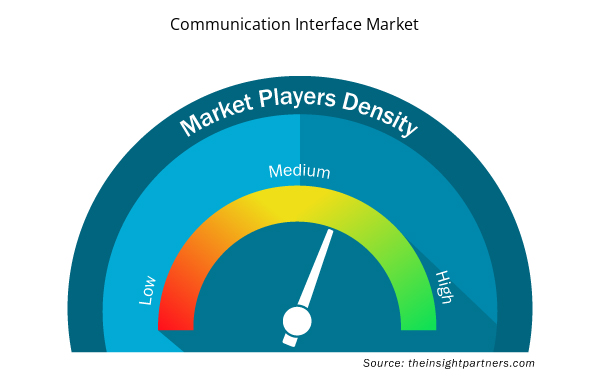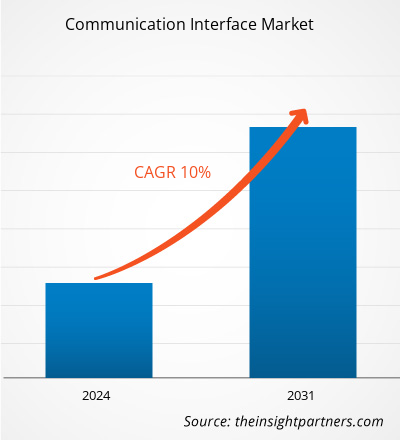通信インターフェース市場規模は、2023年の64億6,000万米ドルから2031年には138億米ドルに達すると予測されています。市場は2023年から2031年の間に10.0%のCAGRを記録すると予想されています。業界全体での自動化技術の採用の増加とロボットの開発の増加は、通信インターフェース市場の主要な推進力とトレンドになる可能性があります。
通信インターフェース市場分析
通信インターフェース市場は、世界的に著しい成長を遂げています。この成長は、業界全体での自動化技術の採用の増加とロボットの開発の増加に起因しています。さらに、インダストリー 5.0 の出現と業界間での集中型製造の採用の増加が、今後数年間で市場を牽引すると予想されています。
通信インターフェース市場の概要
通信インターフェイスとは、あるコンピューターにインストールされたソフトウェア、オペレーティング システム、ディレクトリ、ネットワーク、ネットワーク オペレーティング システム、または Web ベースのソフトウェアが、別のコンピューター上の Microsoft プラットフォーム ソフトウェアと相互運用できるようにするインターフェイスとプロトコルであり、セキュリティ、認証、またはプライバシーを確保するために設計された通信が含まれますが、これらに限定されません。
要件に合わせてレポートをカスタマイズする
このレポートの一部、国レベルの分析、Excelデータパックなど、あらゆるレポートを無料でカスタマイズできます。また、スタートアップや大学向けのお得なオファーや割引もご利用いただけます。
- このレポートの主要な市場動向を入手してください。この無料サンプルには、市場動向から見積もりや予測に至るまでのデータ分析が含まれます。
通信インターフェース市場の推進要因と機会
業界全体で自動化技術の導入が進み、市場が好調
業界全体で自動化技術の採用が増えていることは、確かに通信インターフェース市場を牽引しています。これは、相互接続性の重要性の高まりなどの要因によって推進されています。自動化では、さまざまなシステムとデバイス間のシームレスで便利な通信が強く求められています。通信インターフェースにより、デバイス間のデータ転送と通信が可能になります。一般的な通信インターフェースには、USB インターフェース、HDMI インターフェース、VGA インターフェース、イーサネット インターフェース、ワイヤレス ネットワークインターフェースなどがあります。これらのインターフェースを使用して、コンピューター、外部デバイス、ネットワーク デバイス、モニター、プリンターなどを接続し、データ転送および通信機能を実現できます。業界が自動化の取り組みを拡大するにつれて、新しい要件や拡張に簡単に適応できる通信インターフェースが必要になります。
新興インダストリー5.0。
インダストリー 5.0 という用語は、ロボットやスマート マシンと共に働く人々を指します。これは、モノのインターネット (IoT) やビッグ データなどの高度なテクノロジを活用して、ロボットが人間の作業をより良く、より速く支援することです。これは、インダストリー 4.0 の自動化と効率性の柱に個人的な人間味を加えます。インダストリー 5.0 は、第 4 の反復と互換性のあるプラットフォームと整合し、機械と人間のコラボレーション (つまり、協働ロボット) の重要性に対応する次の産業革新サイクルへの道を開きます。通信ネットワークは、人間と機械の統合とハイパーコネクティビティを維持する上で極めて重要な役割を果たします。モノのインターネット (IoT) とサイバーフィジカルシステム (CPS) の統合など、デバイスがシステムオブシステムズへと進化するにつれて、ネットワークの特性は大きく変化しました。
通信インターフェース市場レポートのセグメンテーション分析
通信インターフェース市場分析の導出に貢献した主要なセグメントは、製品、通信モード、およびアプリケーションです。
- 製品に基づいて、通信インターフェース市場は 1 ポート、2 ポート、その他に分かれています。1 ポート セグメントは、予測期間中に大きな市場シェアを占めると予想されます。
- 通信モードに基づいて、通信インターフェース市場は有線(イーサネット、USB、RS-232/RS-485 など)と無線およびハイブリッドに分かれています。有線(イーサネット、USB、RS-232/RS-485 など)セグメントは、予測期間中に大きな市場シェアを占めると予想されます。
- アプリケーション別に見ると、市場は産業用モニタリング、バッテリー監視システム、リモートセンサー通信、鉄道信号システム、マシン間通信、その他に分類されます。産業用モニタリングは、予測期間中に大きな市場シェアを占めると予想されます。
地域別通信インターフェース市場シェア分析
通信インターフェース市場レポートの地理的範囲は、主に北米、アジア太平洋、ヨーロッパ、中東およびアフリカ、南米および中米の 5 つの地域に分かれています。
北米は通信インターフェース市場を独占してきました。北米地域のさまざまな業界でのハイテク採用の傾向が、通信インターフェース市場の成長を後押ししています。デジタルツールの採用の増加や政府機関による技術支出の増大などの要因が、北米の通信インターフェース市場の成長を牽引すると予想されています。さらに、米国とカナダの先進国では研究開発に重点が置かれているため、北米のプレーヤーは技術的に高度なソリューションを市場に投入せざるを得ません。さらに、米国には革新的なソリューションの開発にますます重点を置いている通信インターフェース市場のプレーヤーが多数存在します。これらすべての要因が、この地域の通信インターフェース市場の成長に貢献しています。
通信インターフェース市場の地域別分析
予測期間を通じて通信インターフェース市場に影響を与える地域的な傾向と要因は、Insight Partners のアナリストによって徹底的に説明されています。このセクションでは、北米、ヨーロッパ、アジア太平洋、中東およびアフリカ、南米および中米にわたる通信インターフェース市場のセグメントと地理についても説明します。

- 通信インターフェース市場の地域別データを入手
通信インターフェース市場レポートの範囲
| レポート属性 | 詳細 |
|---|---|
| 2023年の市場規模 | 64.6億米ドル |
| 2031年までの市場規模 | 138億米ドル |
| 世界のCAGR(2023年~2031年) | 10.0% |
| 履歴データ | 2021-2022 |
| 予測期間 | 2024-2031 |
| 対象セグメント | 製品別
|
| 対象地域と国 | 北米
|
| 市場リーダーと主要企業プロフィール |
|
通信インターフェース市場のプレーヤー密度:ビジネスダイナミクスへの影響を理解する
通信インターフェース市場は、消費者の嗜好の変化、技術の進歩、製品の利点に対する認識の高まりなどの要因により、エンドユーザーの需要が高まり、急速に成長しています。需要が高まるにつれて、企業は提供内容を拡大し、消費者のニーズを満たすために革新を起こし、新たなトレンドを活用し、それが市場の成長をさらに促進しています。
市場プレーヤー密度とは、特定の市場または業界内で活動している企業または会社の分布を指します。これは、特定の市場スペースに、その市場規模または総市場価値に対してどれだけの競合相手 (市場プレーヤー) が存在するかを示します。
通信インターフェース市場で事業を展開している主要企業は次のとおりです。
- ABB株式会社
- イートン社
- ハネウェルインターナショナル
- オムロン株式会社
- ロックウェル・オートメーション
- ゲージングシステムズ株式会社
免責事項:上記の企業は、特定の順序でランク付けされていません。

- 通信インターフェース市場のトップキープレーヤーの概要を入手
通信インターフェース市場のニュースと最近の動向
通信インターフェース市場は、主要な企業出版物、協会データ、データベースなどの一次調査と二次調査を経て定性的および定量的データを収集することで評価されます。通信インターフェース市場の動向のいくつかを以下に示します。
- シーメンスは、LOGO! 通信インターフェース モジュールをリリースしました。複数の通信プロトコル、Modbus RTU/TCP、RESTful API によるアプリ統合、クラウド アクセスの可能性を備えた LOGO! CIM は、まさにゲームチェンジャーです。LOGO! CIM を使用すると、SMS の送受信に加えて、LOGO! 8.3 デバイスから AWS クラウドへのデータ転送が可能になります。統合された GNSS 受信機 (GPS) により、位置を追跡して渡すことができます。(出典: シーメンス カンパニー ウェブサイト、2023 年 5 月)
- インドは、象徴的なエッフェル塔での導入が成功した後、パリの歴史的な百貨店、ギャラリー・ラファイエットで統合決済インターフェース(UPI)を導入しました。(プレスリリース、2024年7月)
通信インターフェース市場レポートの対象範囲と成果物
「通信インターフェース市場の規模と予測(2021〜2031年)」レポートでは、以下の分野をカバーする市場の詳細な分析を提供しています。
- 対象範囲に含まれるすべての主要市場セグメントについて、世界、地域、国レベルでの通信インターフェース市場規模と予測
- 通信インターフェース市場の動向、推進要因、制約、主要な機会などの市場動向
- 詳細なPEST/ポーターの5つの力とSWOT分析
- 主要な市場動向、世界および地域の枠組み、主要プレーヤー、規制、最近の市場動向を網羅した通信インターフェース市場分析
- 市場集中、ヒートマップ分析、主要プレーヤー、通信インターフェース市場の最近の動向を網羅した業界の状況と競争分析。
- 詳細な企業プロフィール
- 過去2年間の分析、基準年、CAGRによる予測(7年間)
- PEST分析とSWOT分析
- 市場規模価値/数量 - 世界、地域、国
- 業界と競争環境
- Excel データセット



Report Coverage
Revenue forecast, Company Analysis, Industry landscape, Growth factors, and Trends

Segment Covered
This text is related
to segments covered.

Regional Scope
North America, Europe, Asia Pacific, Middle East & Africa, South & Central America

Country Scope
This text is related
to country scope.
よくある質問
The expected CAGR of the communication interface market is 10.0%.
The global communication interface market is expected to reach US$ 13.8 billion by 2031.
The key players holding majority shares in the global communication interface market are ABB Ltd., Eaton Corp Plc, Honeywell International Inc, Omron Corp, Rockwell Automation Inc, Gauging Systems; Inc, Parker Hannifin Corp, PR Electronic AS, Socomec Holding SA, NXP Semiconductors NV.
The rising adoption of centralized manufacturing among industries is anticipated to drive the market in the forecast period.
The rising adoption of automation technologies across industries and the increased development of robots are some of the factors driving the communication interface market.
North America is anticipated to dominate the communication interface market in 2023.
Trends and growth analysis reports related to Electronics and Semiconductor : READ MORE..
The Insight Partners performs research in 4 major stages: Data Collection & Secondary Research, Primary Research, Data Analysis and Data Triangulation & Final Review.
- Data Collection and Secondary Research:
As a market research and consulting firm operating from a decade, we have published and advised several client across the globe. First step for any study will start with an assessment of currently available data and insights from existing reports. Further, historical and current market information is collected from Investor Presentations, Annual Reports, SEC Filings, etc., and other information related to company’s performance and market positioning are gathered from Paid Databases (Factiva, Hoovers, and Reuters) and various other publications available in public domain.
Several associations trade associates, technical forums, institutes, societies and organization are accessed to gain technical as well as market related insights through their publications such as research papers, blogs and press releases related to the studies are referred to get cues about the market. Further, white papers, journals, magazines, and other news articles published in last 3 years are scrutinized and analyzed to understand the current market trends.
- Primary Research:
The primarily interview analysis comprise of data obtained from industry participants interview and answers to survey questions gathered by in-house primary team.
For primary research, interviews are conducted with industry experts/CEOs/Marketing Managers/VPs/Subject Matter Experts from both demand and supply side to get a 360-degree view of the market. The primary team conducts several interviews based on the complexity of the markets to understand the various market trends and dynamics which makes research more credible and precise.
A typical research interview fulfils the following functions:
- Provides first-hand information on the market size, market trends, growth trends, competitive landscape, and outlook
- Validates and strengthens in-house secondary research findings
- Develops the analysis team’s expertise and market understanding
Primary research involves email interactions and telephone interviews for each market, category, segment, and sub-segment across geographies. The participants who typically take part in such a process include, but are not limited to:
- Industry participants: VPs, business development managers, market intelligence managers and national sales managers
- Outside experts: Valuation experts, research analysts and key opinion leaders specializing in the electronics and semiconductor industry.
Below is the breakup of our primary respondents by company, designation, and region:

Once we receive the confirmation from primary research sources or primary respondents, we finalize the base year market estimation and forecast the data as per the macroeconomic and microeconomic factors assessed during data collection.
- Data Analysis:
Once data is validated through both secondary as well as primary respondents, we finalize the market estimations by hypothesis formulation and factor analysis at regional and country level.
- Macro-Economic Factor Analysis:
We analyse macroeconomic indicators such the gross domestic product (GDP), increase in the demand for goods and services across industries, technological advancement, regional economic growth, governmental policies, the influence of COVID-19, PEST analysis, and other aspects. This analysis aids in setting benchmarks for various nations/regions and approximating market splits. Additionally, the general trend of the aforementioned components aid in determining the market's development possibilities.
- Country Level Data:
Various factors that are especially aligned to the country are taken into account to determine the market size for a certain area and country, including the presence of vendors, such as headquarters and offices, the country's GDP, demand patterns, and industry growth. To comprehend the market dynamics for the nation, a number of growth variables, inhibitors, application areas, and current market trends are researched. The aforementioned elements aid in determining the country's overall market's growth potential.
- Company Profile:
The “Table of Contents” is formulated by listing and analyzing more than 25 - 30 companies operating in the market ecosystem across geographies. However, we profile only 10 companies as a standard practice in our syndicate reports. These 10 companies comprise leading, emerging, and regional players. Nonetheless, our analysis is not restricted to the 10 listed companies, we also analyze other companies present in the market to develop a holistic view and understand the prevailing trends. The “Company Profiles” section in the report covers key facts, business description, products & services, financial information, SWOT analysis, and key developments. The financial information presented is extracted from the annual reports and official documents of the publicly listed companies. Upon collecting the information for the sections of respective companies, we verify them via various primary sources and then compile the data in respective company profiles. The company level information helps us in deriving the base number as well as in forecasting the market size.
- Developing Base Number:
Aggregation of sales statistics (2020-2022) and macro-economic factor, and other secondary and primary research insights are utilized to arrive at base number and related market shares for 2022. The data gaps are identified in this step and relevant market data is analyzed, collected from paid primary interviews or databases. On finalizing the base year market size, forecasts are developed on the basis of macro-economic, industry and market growth factors and company level analysis.
- Data Triangulation and Final Review:
The market findings and base year market size calculations are validated from supply as well as demand side. Demand side validations are based on macro-economic factor analysis and benchmarks for respective regions and countries. In case of supply side validations, revenues of major companies are estimated (in case not available) based on industry benchmark, approximate number of employees, product portfolio, and primary interviews revenues are gathered. Further revenue from target product/service segment is assessed to avoid overshooting of market statistics. In case of heavy deviations between supply and demand side values, all thes steps are repeated to achieve synchronization.
We follow an iterative model, wherein we share our research findings with Subject Matter Experts (SME’s) and Key Opinion Leaders (KOLs) until consensus view of the market is not formulated – this model negates any drastic deviation in the opinions of experts. Only validated and universally acceptable research findings are quoted in our reports.
We have important check points that we use to validate our research findings – which we call – data triangulation, where we validate the information, we generate from secondary sources with primary interviews and then we re-validate with our internal data bases and Subject matter experts. This comprehensive model enables us to deliver high quality, reliable data in shortest possible time.


 このレポートの無料サンプルを入手する
このレポートの無料サンプルを入手する